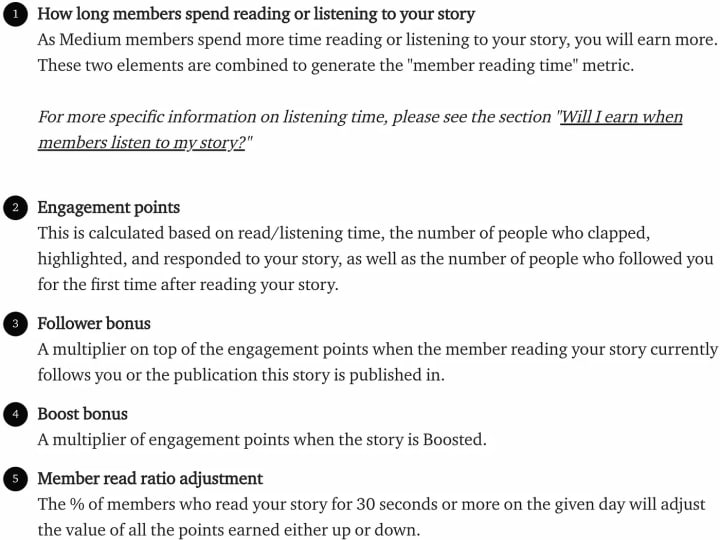The Definitive Guide for Writing a $700+ Story on Medium
There are things more important when calculating payout than just getting views and reads

Summary
This article will first review the five factors that Medium uses to determine how much you get paid for each article, and then offers techniques for improving on each of those metrics. It concludes with a list of actionable takeaways.
Stats
I’ve written plenty of articles, but only recently did I write my most profitable one. It was an eye-opening experience. I gleaned a ton of insight from reviewing why that one in particular made so much, but the most surprising thing was that my most profitable article ever was not my most viewed article, not by a long shot. Now that I know that, it changes everything.
Let’s review the stats on that article versus some others, and then we can get underway with the how-to portion of the article.

My most profitable article ever is “The 5 Factors That Determine Compatibility in a Relationship.” If you look at the stats for the three articles above, you’ll see that I’ve written an article with even more views, but it made about one-thirtieth of the money! You may have noticed, however, that it did have less reads. But if reads were all that mattered, then “Why You Really Shouldn’t Talk About Your Relationship With Other People” would still have made something approaching $500 (since it has roughly 3/4 the readers as “The 5 Factors…”). So why such a huge discrepancy? Initially, I was at a loss to answer that myself, so I reached out to Medium support directly. Support, then, directed me to the page that shows how Partner Program earnings are actually calculated. Here’s what it says are the factors involved in calculating payout:

And here is the formula for how these factors relate to each other:

Now that we understand how exactly our payout is calculated, let’s use what we’ve learned as a framework for writing a profitable article. We need to try to accomplish these 5 things with each article: 1) boosted by the algorithm, 2) lots of views, 3) different types of engagement, 4) getting a follower bonus, and 5) reads.
1. Getting Boosted
An article that gets “boosted” is distributed by the Medium algorithm, so that it shows up in more reader’s feeds, emails, etc. As you saw above, it also comes with a financial bonus for Partner Program members!
Under Medium’s “Boost Guidelines,” they write that the top criteria for boosted articles is that they “help readers deepen their understanding of themselves, others, their endeavors, or the world.” Other factors they consider are whether or not the story enriches the life of the reader, is both original and not AI, is born from the author’s experience, and the overall quality of the story. This information is important to consider, but it’s also very general.
The best way to guarantee we get a story boosted is by going through the “Boost Nomination” program. This is a pilot Medium began last year that allows the editors of certain publications to choose to boost the articles they publish. Three publications that have recently boosted my work are “Mind Cafe,” “An Injustice!,” and “Health and Fitness.” (I’ve linked the names of these publications to the articles of mine that each of them boosted, to serve as examples of “boost-worthy” articles.)
The ultimate Medium guru, Kristina God, MBA, has been kind enough to put together a list of 60 boosted publications.
2. Garnering Views
If your article is getting boosted, you’ve already come a long way to getting more views, but there’s still more to be done. The good (and bad) thing about trying to get views is it doesn’t actually depend on the content of your article; this is based solely on the title, subtitle, and cover image.
You want a title that conveys exactly what your article is about in as few words as possible. The less confusing it is the better. However, it should also be enough to intrigue the reader.
My most viewed titles are as follows:
- Why You Really Shouldn’t Talk About Your Relationships With Other People
- The 5 Factors That Determine Compatibility in a Relationship
- 10 Timeless Books With Less Than 150 Pages
- Why Your Writing Might Be Too Good to be Popular
- How I Wrote a #1 Book in Two Days
- Why It’s So Hard To Say How You Feel
- Why Writing Takes Courage
There’s a few reasons these titles ended up getting the clicks they did. First, some have a huge value proposition. Learning ‘why it’s hard to say what you feel” or how to “determine compatibility in a relationship” is going to be a big deal for most people. Think about what your readers gain from reading your article and put that in the title.
Another good thing to add is a degree of shock value. Writing being “too good to be popular” or writing a #1 book in just “two days” almost doesn’t make sense on its face, so the reader is intrigued to learn more.
A third method is to try to reach readers where they are. “Why Writing Takes Courage” was a hit because it spoke to what a lot of the people on Medium are actively going through. You want a title that speaks directly to the experiences readers are having in their personal lives. “Why You Really Shouldn’t Talk About Your Relationships With Other People” is another example of this.
Finally, in our modern, fast-paced world, most people don’t make very much time to read, so you need to try to downplay the time commitment that reading your article entails. That’s what’s great about listicles. It tells the reader, “Here are 5 skimmable points.” Some other writers might put “easy steps” or “simple tips” to drive this point home.
3. Stirring Up Engagement
First, let’s review what the different forms of “engagement” are. This is going to be the number of people who clapped, highlighted, and responded to your story, as well as the number of people who followed you after reading the story. Let’s approach them one at a time.
A clap is akin to a “like” on other platforms. As long as you’re doing your job, and giving people something worth reading, they’re going to reward you with claps. However, to really bring out enthusiasm from readers, you’re going to want to hone in on some of the things that were mentioned in the section on “views,” specifically the value proposition and reaching the reader where they are. We’re most grateful to the writers who teach us something we can use in a practical way or who tell us something we can relate to on a personal level. Focus on doing one or both of these to get more claps.
The simple cheat to get people to highlight your story is to put particularly important or hard-hitting lines of text in bold. This signals to the reader what’s important and thereby what they’re likely going to want to save for later. Another cool technique some writers use is by including great quotes from other writers. These often get highlighted by readers. And in the words of the famous writer Anatole France, “When a thing has been said and said well, have no scruple. Take it and copy it.”
The three best ways I’ve found to get people to respond to a story: 1) writing something that readers connect with on a personal level, 2) delving into subjects that are a bit controversial, or 3) focusing on niches. We’ve already gone over the first one enough, so let’s focus on the last two.
Articles that focus on politics, or that are a bit critical, can get a lot of responses. Here are some articles I’ve written that did this well:
- How Highly Sensitive People Control the Rest of Us (47 comments)
- Should the U.S. Pay Reparations to Black Americans? (78 comments)
- The Death of Intellectual Curiosity in Patient-Facing Medicine (30 comments)
These articles made people want to express their agreement or disagreement with what I said, and that’s great for engagement. Another way to achieve this is by focusing on niches. Medium has large communities for design, entrepreneurship, writing, etc. When you speak on something that your audience has a technical understanding of, they’re going to want to voice their opinions as well. Some of my articles with the most engagement are about writing, such as these:
- Should a Writer Be a Person or a Brand? (78 comments)
- How I Went From Amateur to Professional Writer in 30 Days (43 comments)
- Why Your Writing Might Be Too Good to Be Popular (135 comments)
Finally, to up the number of people who follow you off an article is as straightforward as it is challenging. You need to deliver something so impactful to the reader that when they finish with your article, they say to themselves, “I need more of this.” Luckily, if you follow everything else laid out in this article, you should be able to do just that.
4. Reaping a Follower Bonus
As was stated in the breakdown of how compensation for your article is calculated, if the person reading your article is the follower of either you or the publication the article is in, you get extra money for it.
An obvious first step: Try to get your article into a publication with a lot of followers! You can find a list of the top 20 publications that are actively accepting submissions here.
The key to building your personal following is consistency. However, this consistency has to occur across a number of dimensions. First off, readers want consistent quality. If they read one great thing from you, and then the next two articles are shabby, they’re going to unfollow.
Second, they want a consistent pace of articles. Putting out new stories too frequently or too rarely are both dangerous. I aim for once a week or once every two weeks, though this is by no means a hard and fast rule. You just want to not post so often that followers who are subscribed to get your email notifications are annoyed, and not so infrequently that readers forget why they’re following you in the first place.
Finally, readers like consistent themes in your articles. This has always been hard for me to adhere to and was the subject of an article mentioned earlier, “Should a Writer Be a Person or a Brand?” Just like we tend to find it off-putting if our favorite rapper changes genres to put out an instrumental album that mostly consists of them playing the flute (true story), we tend to follow people for more of what we liked from them in the past. If you can remain focused on one subject matter that relates to a popular niche on Medium, it can do great things for your follower count.
As something of a “postscript” (P.S.) for this section, it should be noted that outside of just writing stories, you can gain followers by interacting with other people on Medium. Engaging with the stories that your fellow writers put out, and commenting under their posts, can be a doubly rewarding experience. For one, there’s a lot of great content and great people on the platform, and, secondly, people tend to check out your content in return. Introduce reading and interacting with 5 or 10 short articles a day into your writing schedule, and watch how it helps.
5. Extending the Reading Time
Some easy tricks for getting people to actually read after viewing are to use short paragraphs, start with a simple summary/outline of the article, number your points, and keep your read time relatively short.
Short paragraphs make the process of reading feel less cumbersome and like you’re progressing through the story faster. The opening summary and the listicle format work to give the reader some sense of what’s to come, and this makes them feel like they’re missing out if they close out your article without at least taking a look at the whole thing. Finally, I aim for a 7-minute read time. Some popular writers go even shorter. You only need 30 seconds for an article to count as “read.” A 12-minute article is a lot more daunting an undertaking than a 5-minute one.
You also want return readers. This comes from getting people to bookmark your articles. The absolute best way to get people to bookmark one of your articles is to load it up with useful information. If the information is of practical importance to them, they’re going to want to return to it. If that practical information is also laid out in extensive detail, they’re going to have to return it. Understand what I’m saying? Give the reader more than they can readily memorize. Another trick is in the organization of the article. If the article is formatted like a reference guide, then people are more likely to treat it like one.
Conclusion
If you want to make real money on Medium, try to accomplish these 5 things in every article you put out: 1) boosted by a publication, 2) lots of views, 3) different types of engagement, 4) a follower bonus, and 5) convert views to reads.
Here are the key takeaways on how to do just that:
- Submit articles to boosted publications.
- Use titles that communicate what your article is about in as few words as possible, and that present a value proposition, reach the reader on a personal level, use shock value to draw the reader in, and/or downplay the time commitment of the article.
- Give readers practical information or touch them on a personal level to elicit the sense of gratitude that will have them “clap” for your story.
- Bold text that is particularly important so that the reader can follow your lead and highlight those sentences.
- Include quotes from other people that readers are likely to highlight.
- Write on personal, controversial, and niche subjects to elicit responses from readers.
- To earn a follower bonus, aim to get your articles into publications with lots of followers and work to build up your own following by staying consistent.
- Be an active part of the Medium community and engage with other people’s content to gain even more followers.
- To get people to keep reading after viewing use short paragraphs, start with a simple summary/outline of the article, number your points, and keep your read time relatively short.
- To get repeat readers load your articles up with more practical information than they can readily memorize and format it like a reference guide.
In this article, I sought not only to explain the techniques I’ve learned for writing a story that can end up making hundreds of dollars but to also exemplify what I’ve learned. This article should serve as a model for what a $700+ article looks like. I have no idea if it’ll perform as well as intended, but if it does, then we can be sure that the tips and techniques herein are worth the time it took you to read about them.
Enjoy this article? Checkout my new book: “On Authorship: Essays on the Emotional Realities of Being a Professional Writer.”
About the Creator
Martin Vidal
Author of A Guide for Ambitious People, Flower Garden, and On Authorship
martinvidal.co
martinvidal.medium.com
Instagram: @martinvidalofficial
Enjoyed the story? Support the Creator.
Subscribe for free to receive all their stories in your feed. You could also pledge your support or give them a one-off tip, letting them know you appreciate their work.






Comments
There are no comments for this story
Be the first to respond and start the conversation.